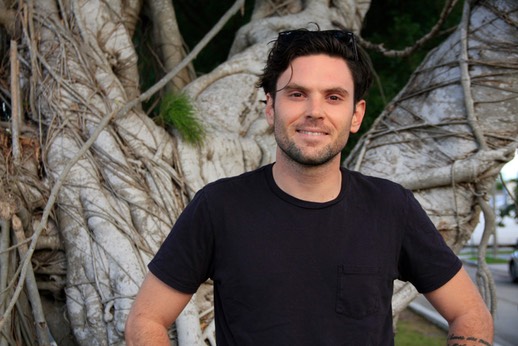
BIO
Mario Alejandro Ariza is a Dominican immigrant and a Michener Fellow in poetry at the University of Miami’s Master in Fine Arts program. He holds a Master’s degree in Hispanic Cultural Studies from Columbia University. His poetry can be found in places like The Cincinnati Review, Gulf Coast, and The Raleigh Review, and his journalism appears in The Atlantic and The Miami New Times. His current project focuses on sea level rise and Miami.
3 Poems
Death Mask of the Black Messiah
“Have had an encounter with Olivorio's group at a place called “devil’s field.” The engagement occurred at 7:00 am. Killed four, including the Bandit “God” Olivorio. His corpse has been brought down to San Juan. Have captured 14 carbines, 6 pistols, and 150 rounds of ammunition. No casualties suffered.”
— Telegram sent by Major Ansel Williams, 5th Marines, June 29th, 1922
After what happened, a white man took the picture.
Bullet riddle. Nose broken. Rope tie. Corpse,
whose hands had worked now stolen lands. Cut -
lass wound spilling out rum, puss, mare’s milk.
This is what didn’t happen: resurrection, unceasing
scansion of a rebel’s heart, Jesus saying to Thomas
“Extiende aquí tu mano, y ponlo en mi costado.”
The photo states: Stop doubting death and believe.
A black messiah has been killed for holy insurrection.
His disciples had bound together to shoot marines.
His likeness is printed, posted, a warning to a conquered
people: “Here is your ululating tongue of fire, cut out.”
For many, it’s their first photograph: bloodcrust
body strung between two stout poles, lifeless neck
of Olivorio tilting dead eyes heavenward. Faith
works backwards, however, and is known to be blind.
Intercession
I can’t talk to god no more, won’t you call him for me on
the landline?
It still works when the power’s out. He’ll probably say:
“Fuck those lard
Loving asshats over at the Santo Domingo Country Club,
little white
umbrellas in their mixed drinks.” He’ll boast that no wall
capped
by jagged bottle shards lambent in the sun can interdict his
radical love.
But please, if y’all do talk, ask about that fat-ass gout
ridden colonel
pandering for bribes on the border between Santo Domingo and
Haiti,
ask him what the payment is when a Haitian woman hasn’t the
cash.
Ask also after that visiting Polish Cardinal exchanging
medicine
for blowjobs from skinny brown shoeshine boys under the
statue
of Fray Antonio de Montesinos down at the quiet end of the
Malecón, where even the famished pigeons don’t talk. Oh, y
antes
de que se me olvide, ask after that country which can’t love
itself;
The Dominican Republic, island with its mind on Europe,
brown
melao skin blistered by sun. Pregúntale a Díos también about
Johnny
Abbes, Trujillo’s military intelligence chief, who killed my
great grandfather,
whose espiritu stalks my yellow fever dreams, a machete
called justice lodged
in its skull. Is there forgiveness for him, for the
fascists, the genocidaires?
God will quote Aquinas, or Merton at you. Don’t listen.
Johnny repeats
a sermon each night he appears: “The Real Academia of
Language disapproves
of your mongrel espanglish, your spirits sits under the
Puerta del Sol, not
with it’s feet in the Rio Massacre.” Listen if I should fail
to wake up, evil
will still persist, in spite of the omnipresence of God’s
love. But know that dead,
you and I can be anywhere; aqúi in Nueva Yol, or in Cádiz
caliente, or dozing
in Dajabón; and they are hungry in Ouanaminthe, and God, who
is still silent, who
makes me feel like when I catch my lover texting dirty
pictures to another man?
The
Map
After Elizabeth Bishop
Cliffs that break this crumbling city from the sea
become bronze triangles. Faint green dashes
outline a tyrant’s neat new neighborhoods,
drawn on the Napoleonic Plan. The hot, dense
venereal quarters of the Old Colony are done
in syphilitic red. Even if the mapmaker had
to change the city’s name, this corner of his atlas
is at least coyly honest: Ciudad Trujillo gets writ
in sulphurous font, while little blue letters cool as
azulejos abutt an aged cathedral; they whisper
Santo Domingo de Guzmán. A new airport, now
Old, edges these wards hungrily as a starfish
would an urchin. Verlaine once said the forms
of cities change faster than the souls of men,
he wrote that as Napoleon the 3rd was ripping up
Old Paris by the roots. On this island, the souls
of men don’t seem to change. If the map were modern,
riotous slums would enjamb the mullioned precincts,
but this is an old projection, drawn by a steady hand;
Urbi the New World’s oldest city, Orbi the island it slowly
ruins. Fell mountains like bone spurs stretch strip-mined
topaz east to west, greenish phlegmatic polluted rivers vein
towards a plastic choked sea, an ox blood salt lake shines
like an endangered cayman’s eye in the mangroves at night.
Every exhausted bauxite mine, each now abandoned sugar
mill and dead palm oil plantations get clearly labeled in
dun
dingy ink. Of course the free maroon hold-fasts are erased,
and the tierras comuneras expropriated by invading
Americanos
get named after the gran familias the gringos gave them to:
Robles,
Hatuey, Des-champs, Vicini…The eye wanders west, and yes
the map extends to Haiti, though here the palette changes:
the forceful browns turn famelic around the Massif Du Nord,
the black of Jérémie is
obscure and absolute; Le Cap gets
oddly ignored. Only prideful Port au Prince (now laid so low
by earthquake) receives La
Capital’s pop out treatment: it
extends like a hand that’s crawled out of the sea to grab
all of the low hills around it, the mapmakers lines pointing
imagined lusts and hungers to the east, subtly blaming this
brother capital for the island’s ills, as if to optically
justify
some despot’s genocide. It’s sad, really; how all maps lie.